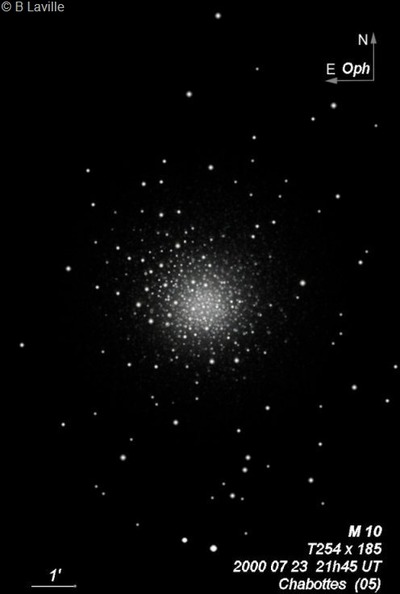
Charles Messier discovered M10 = NGC 6254 = h1972 on 29 May 1764. William Herschel first observed the globular on 21 May 1783 with his 8-inch (10-ft focal length) and noted "With 227 I suspected it to consist of stars; with 460 I can see several of them, but they are too small to be counted." In 1784 and 1791 he observed M10 with his 18.7-inch and noted "A beautiful cluster of extremely compressed stars; it resembles the 53d [M53]; and the most compressed part is about 3 or 4 minutes in diameter."
On 1 Jun 1831 (not registered as a sweep), John Herschel logged, "a superb cluster of very compressed stars, gbM. The stars are 10...15m, and run up to a blaze in the centre, but I see no nucleus. Diam about 6'; a noble object." His first observation was on 30 May 1821, the second night he was learning how to sweep.
200/250mm - 8" (6/19/82): bright lively core highly resolved. The outer halo is highly resolved with several long, distinct streamers.
300/350mm - 13.1" (6/19/82): very bright, fairly large, intense core richly covered with fairly bright stars. Scores of stars are resolved in the outer halo.
400/500mm - 17.5" (7/15/99): beautifully resolved at 220x. The halo appears to extend to nearly 14' although the star density is very low in the outer edge of the halo. The inner halo is sharply concentrated with a very bright 5'x4' core which is elongated SW-NE. The cluster is highly resolved into mag 12/13 stars from edge to edge (too numerous to count) with the stars very densely packed over the core. A second layer of mag 13/14 stars is superimposed over the core. The halo contains a number of strings including a long string to the south which curves east and a string to the north which curves west. Also two parallel linear strings head north or NNE from the core.
Notes by Steve Gottlieb